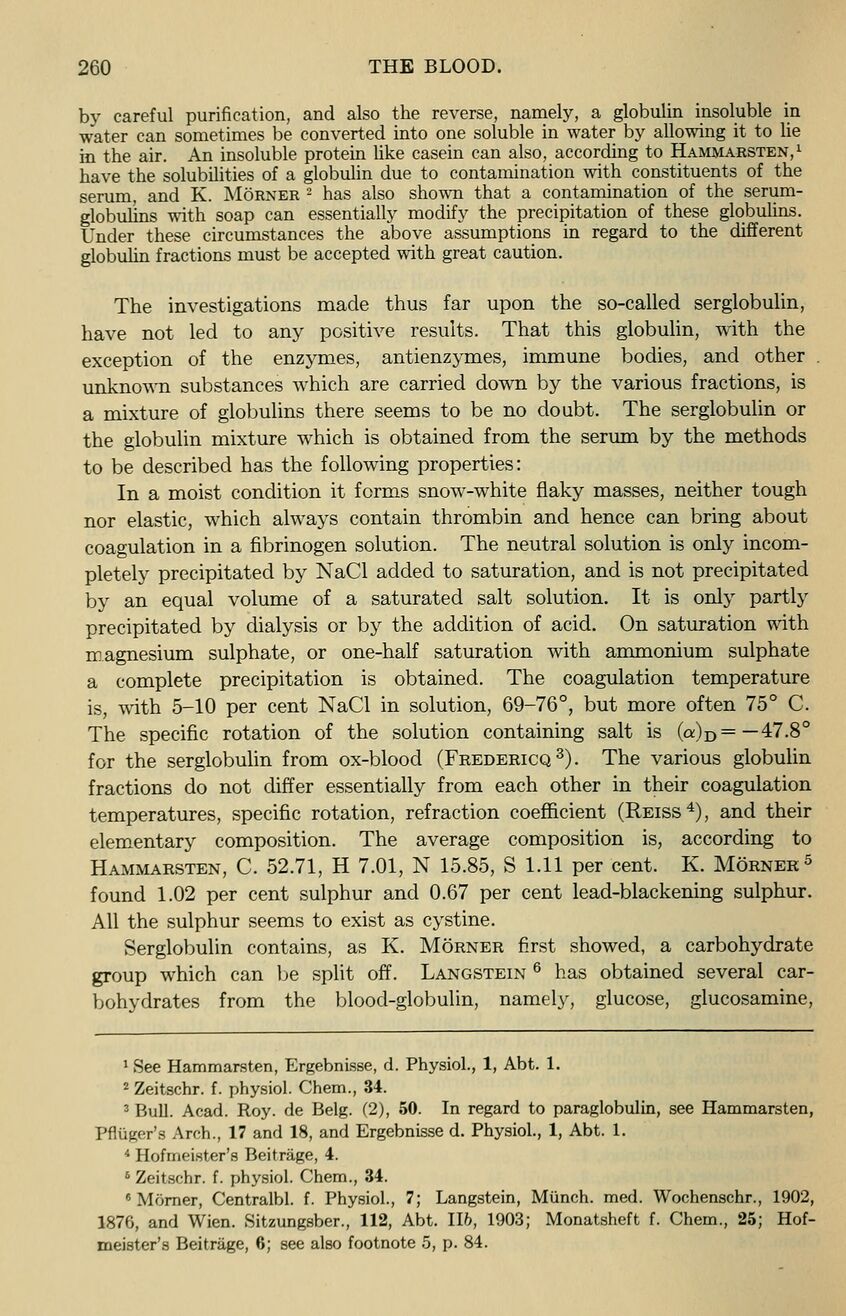
Full resolution (JPEG) - On this page / på denna sida - V. The Blood - I. Blood-plasma and Blood-serum - The Blood-plasma

<< prev. page << föreg. sida << >> nästa sida >> next page >>
Below is the raw OCR text
from the above scanned image.
Do you see an error? Proofread the page now!
Här nedan syns maskintolkade texten från faksimilbilden ovan.
Ser du något fel? Korrekturläs sidan nu!
This page has never been proofread. / Denna sida har aldrig korrekturlästs.
260 THE BLOOD.
by careful purification, and also the reverse, namely, a globulin insoluble in
water can sometimes be converted into one soluble in water by allowing it to lie
in the air. An insoluble protein like casein can also, according to Hammarsten, 1
have the solubilities of a globulin due to contamination with constituents of the
serum, and K. Morner - has also shown that a contamination of the serum-
globulins with soap can essentially modify the precipitation of these globulins.
Under these circumstances the above assumptions in regard to the different
globulin fractions must be accepted with great caution.
The investigations made thus far upon the so-called serglobulin,
have not led to any positive results. That this globulin, with the
exception of the enzymes, antienzymes, immune bodies, and other .
unknown substances which are carried down by the various fractions, is
a mixture of globulins there seems to be no doubt. The serglobulin or
the globulin mixture which is obtained from the serum by the methods
to be described has the following properties:
In a moist condition it forms snow-white flaky masses, neither tough
nor elastic, which always contain thrombin and hence can bring about
coagulation in a fibrinogen solution. The neutral solution is only incom-
pletely precipitated by NaCl added to saturation, and is not precipitated
by an equal volume of a saturated salt solution. It is only partly
precipitated by dialysis or by the addition of acid. On saturation with
magnesium sulphate, or one-half saturation with ammonium sulphate
a complete precipitation is obtained. The coagulation temperature
is, wr
ith 5-10 per cent NaCl in solution, 69-76°, but more often 75° C.
The specific rotation of the solution containing salt is (a) D =—47.8°
for the serglobulin from ox-blood (Fredericq 3
). The various globulin
fractions do not differ essentially from each other in their coagulation
temperatures, specific rotation, refraction coefficient (Reiss 4
), and their
elementary composition. The average composition is, according to
Hammarsten, C. 52.71, H 7.01, N 15.85, S 1.11 per cent. K. Morner 5
found 1.02 per cent sulphur and 0.67 per cent lead-blackening sulphur.
All the sulphur seems to exist as cystine.
Serglobulin contains, as K. Morner first showed, a carbohydrate
group wdiich can be split off. Langstein 6
has obtained several car-
bohydrates from the blood-globulin, namely, glucose, glucosamine,
1
See Hammarsten, Ergebnisse, d. Physiol., 1, Abt. 1.
2
Zeitschr. f. physiol. Chem., 34.
3
Bull. Acad. Roy. de Belg. (2), 50. In regard to paraglobulin, see Hammarsten,
Pfliiger’s Arch., 17 and 18, and Ergebnisse d. Physiol, 1, Abt. 1.
4
Hofmeister’s Beitrage, 4.
6
Zeitsrhr. f. physiol. Chem., 34.
8
Morner, Centralbl. f. Physiol., 7; Langstein, Munch, med. Wochenschr., 1902,
1876, and Wien. Sitzungsber., 112, Abt. lib, 1903; Monatsheft f. Chem., 25; Hof-
meister’s Beitrage, 6; see also footnote 5, p. 84.
<< prev. page << föreg. sida << >> nästa sida >> next page >>